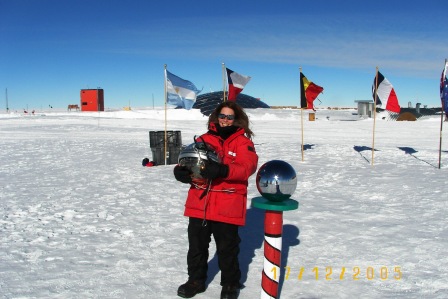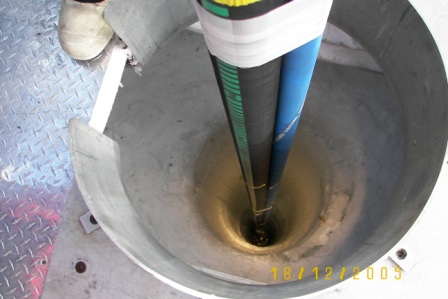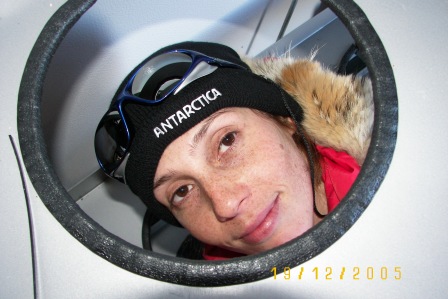Dr. Hagar Landsman (Peles) smiles when she talks about Antarctica – the featureless landscape, the - 40°C temperatures in summer, the relentless midnight sun. “It’s a very special place,” she says. Landsman has already made two trips to the South Pole, and she hopes to go again in the next southern summer – sometime between November and February.
Landsman is a member of the international “IceCube” research team – IceCube being a unique sort of telescope, one that tracks particles called neutrinos, rather than light. Though quite common, neutrinos are almost impossible to detect. They are nearly without mass and carry no charge, and they very rarely interact with normal matter. The only way to detect them is to look for signs of those rare interactions.
In recent years, science has revealed much about these elusive little particles – for instance, the fact that they can change from one type to another as they zip through space – but many mysteries remain. One of those mysteries is the source of certain high-energy neutrinos connected with cosmic phenomena known as gamma ray bursts. Observing neutrinos from these bursts might help researchers understand their origins and how they are produced. Neutrinos are also believed to be connected to mysterious cosmic rays and could shed light on puzzling phenomena that have been observed in these rays. In addition, neutrinos might yield clues to the unseen side of the universe – dark matter. “People have been using photons (light) to observe the universe since the dawn of history,” says Landsman. “In IceCube we use neutrinos for astronomy, which gives us a fresh and exciting view.”
Landsman has been working on IceCube for the past eight years – since receiving her Ph.D. in physics from the Technion, Haifa, and going on to postdoctoral research at the University of Wisconsin. Her main responsibility has been calibrating and testing, and ensuring that all of the 5,000 detectors now buried under the Antarctic ice function properly.
Completed just last year, IceCube is an enormous array of light detectors, one cubic kilometer in size, buried at a depth of 2.5 km below the polar ice. At this depth, there is total darkness. Yet rare bursts of light occur in those infrequent cases in which a neutrino interacts with the million tons of ice. Down there, the ice is crystal clear, and a burst of light can travel hundreds of meters, reaching a number of IceCube’s light detectors.
Each basketball-sized detector, says Landsman, undergoes several months of rigorous testing and calibration. Once it is encased in ice, there is no moving or repairing it. Yet it is expected to function for the next decade. At the South Pole, Landsman retests and readjusts the detectors one last time before sending them down the boreholes into place.
Trips last a month – three weeks “on the ice” and another week in transit – though the Antarctic’s unpredictable weather can extend travel time by days. In those three weeks, Landsman works nearly around the clock, not just because it is light 24 hours a day, but because she feels the need to accomplish as much as possible in the short time she has there. “All of the 150 or so people at the South Pole Station – researchers, engineers and support staff – work this way. The cost of bringing a person there is so high that only truly necessary people are allowed. Housekeeping chores – from cleaning toilets to washing dishes – are shared by all.”
Most of Landsman’s work is outdoors. At an elevation of 2,800 m, altitude sickness is a problem, and the extremely dry air is even more troublesome than the cold. The conditions slow the work down: “If you forget a screwdriver, it can take two hours to go back and get it,” she says. Indoors, the station is kept cool to save on heating, and showers are limited to two minutes twice a week. “One gets used to it all,” says Landsman. And once in a while, the work stops for entertainment – for instance, the Christmastime “race around the world”: a circumpolar run accompanied by snow vehicles fitted out as parade floats by the station’s engineers.
A change of scenery
Landsman’s most recent work trip was much closer to home – to Italy. At the Weizmann Institute, Landsman is a member of the Particle Physics and Astrophysics Department in the group of Profs.
Ehud Duchovni,
Eilam Gross and
Amos Breskin. Specifically, she is a key member of the Weizmann team participating in the XENON project, which is attempting to find evidence for dark matter particles with a detector deep underground in Italy’s San Grasso National Lab. The team is now building a new detector that will hold a ton of liquid Xenon. Landsman is involved both in data analysis and in planning the new device.
She is also involved in planning and installing the next neutrino project at the South Pole. Known by the acronym ARA, the new project will eventually be 100 km. sq, with detectors spaced a kilometer apart. The new detectors work with radio waves, rather than light waves, and can thus be placed under just 200 m of ice. Landsman describes ARA as “a really big net, designed to catch the biggest fish” – in this case the highest-energy neutrinos.
Waiting for a particle
Earth’s atmosphere is under a constant barrage of extremely high energy cosmic rays – exceeding a hundred million gigavolts. (That’s a million times the energy of the most energetic particle created in a lab.) The source of these particles and their means of production are still unknown. The Weizmann Institute’s
Prof. Eli Waxman and the late Prof. John Bahcall proposed that these particles are produced near young black holes with masses similar to that of the sun, and that such black holes are also responsible for the production of strong gamma ray bursts. One of the central aims of the giant IceCube project in Antarctica is to test this theory, by searching for high-energy neutrinos that are predicted to be produced alongside the cosmic rays and gamma rays. As yet, the detector has not found these high-energy neutrinos, but according to the model proposed by Waxman and Bahcall, the number of neutrinos this detector is likely to record is relatively tiny, so that data will need to be collected over a period of five to ten years before any conclusions can be drawn.
Prof. Amos Breskin’s research is supported by Erica A. Drake and Robert Drake; the Nella and Leon Benoziyo Center for High Energy Physics; the estate of David Turner; and the Friends of Weizmann Institute in memory of Richard Kronstein. Prof. Breskin is the incumbent of the Walter P. Reuther Chair of Research in Peaceful Uses of Atomic Energy.
Prof. Ehud Duchovni’s research is supported by the Friends of Weizmann Institute in memory of Richard Kronstein; the Nella and Leon Benoziyo Center for High Energy Physics; and the Yeda-Sela Center for Basic Research. Prof. Duchovni is the incumbent of the Professor Wolfgang Gentner Professorial Chair of Nuclear Physics.
Prof. Eilam Gross’s research is supported by the Friends of Weizmann Institute in memory of Richard Kronstein.
Prof. Eli Waxman heads the Benoziyo Center for Astrophysics. Prof. Waxman is the incumbent of the Max Planck Professorial Chair of Quantum Physics

.jpg)
.jpg)


